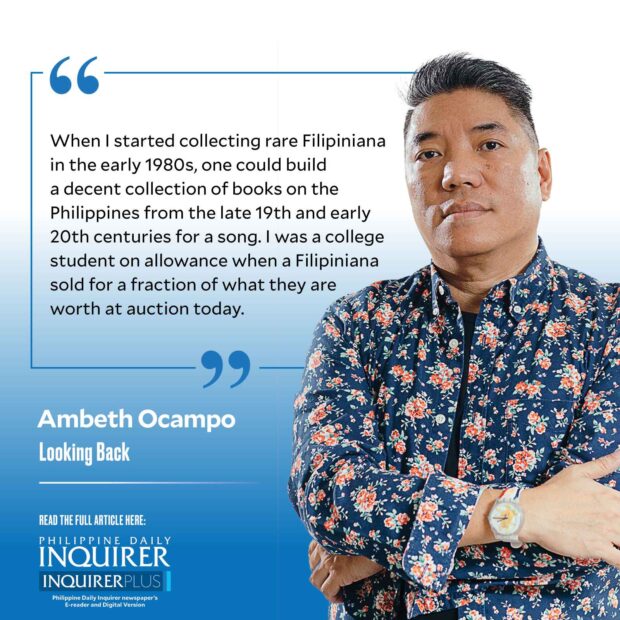Bibliomania

Buying and selling to support my bibliomania left me with three big regrets. First, was Jose Rizal’s “El Filibusterismo” published in Ghent, Belgium, in 1891, a first edition hand-picked from a home in Marikina for P200. Resold later for P8,000, it is worth at least a million today. Second, Fedor Jagor’s “Reisen in den Philippinen” a travel account of the Philippines published in Berlin in 1873. This rare autographed copy was in a Harrison Plaza tiangge for P150. It was given to a specialist who didn’t charge me for two operations and consultations. Third, “Historia de las cosas mas notables, ritos y costumbres del gran reyno de la China …” Juan Gonzalez de Mendoza wrote on China with a relevant section on the Philippines. Published in 1596, this was the oldest book in my library until it was acquired, together with all my rare books, by the Kyoto University Center for Southeast Asian Studies Library.
People impressed by my library today have to be reminded that it was not built magically overnight, but was painstakingly acquired book by book over the span of four decades. My first book acquisitions were from bookstores in Makati: Casalinda bookshop in San Antonio Plaza, Forbes Park, specialized in Philippine books unlike the others where Filipiniana formed a small part of the inventory; Erehwon (that I learned later is “nowhere” spelled backward), Philippine Education Co. or “Peco,” Bookmark, and Alemars. Goodwill bookstore had nothing I wanted, but its cousin National Bookstore, particularly the huge Quezon Avenue branch, had bargain bins with Nick Joaquin essay compilations and literary anthologies published by the playwright Alberto S. Florentino that nobody wanted, not even at one peso each! Popular Bookstore on Doroteo Jose, better known for professional and “subversive” titles, was just too far away. Rare Filipiniana was to be found buried in textbook stalls along Recto Avenue and the University Belt, some were sourced cheaply from Ermita antique shops, then there was the bodega of the prewar Libreria Martinez behind the Ihaw-ihaw girlie bar, off the Welcome Rotonda on Quezon Boulevard.
Article continues after this advertisementBook hunting in the 1980s was a hobby, like collecting stamps, coins, Coca-Cola bottles, or Barbie dolls. Today, almost everything is online. Antiquarian books weren’t the investments and portfolio assets they have grown into today. When I was starting out as a historian over three decades ago, I was advised to build a personal library because that was to be both my arsenal and my refuge. While rare Filipiniana is priced way beyond the salary grade of academic historians, the good thing is that much of them can be accessed online and even downloaded in high resolution for free. I am more pragmatic now and can carry my entire reference library on an external drive. When bibliophiles wax romantic over the tactile pleasures of handling physical books, or the scent of aged paper and printer’s ink between leather covers, I smile and let them know that a working historian needs content more than a rare volume. After all, content can be online, digital, photocopied, or even read in a library.
A Filipino historian does not need to own rare Filipiniana anymore. As a matter of fact, a library is a burden because it needs lots of shelf space. It needs air-conditioning or dehumidifiers to protect books from foxing and molds. It has to be dusted and regularly inspected to guard against silverfish, termites, and vermin that love the taste of binder’s glue and parchment. Young dogs love to chew on covers and bindings, even if these do not have the grit and flavor of beef bones. Then, we have the biggest enemy of books—humans. Some people don’t know how to handle books with care. The worst are those who never return what they borrowed. In some ancient European libraries, rare books are not just kept under lock and key, they are chained to the shelves! The University of Salamanca Library has a plaque on the wall that, translated from the original Spanish, warns: “Excommunication is reserved to His Holiness against any person that might remove, lose, or by any other means alienate any book, parchment, or document of this library, without possible absolution until these (objects) be perfectly returned.”
In a world where people get information off their smartphones, many libraries are forced to justify their existence by counting “readers” there, largely for free aircon and Wi-Fi. Rare and special collections attract only a handful of users but are repositories of culture and heritage that need to be better known and utilized.
Article continues after this advertisementComments are welcome at aocampo@ateneo.edu
















